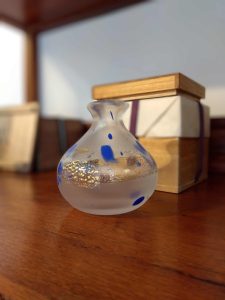歳を取ると漬けたくなるのでしょうか(愛知県名古屋市千種区姫池通 骨董買取 古美術風光舎)
2025.06.15

今年もやってまいりました。スーパーや産直売り場には梅やらっきょうが並び始め、「さあどうぞ漬けてください」と言わんばかりにあの赤い蓋の保存瓶やらが所狭しと陳列されています。
歳を重ねるごとに健康へのこだわりなんかも出てくるのでしょうか。友人の中には家で使う調味料のほとんどを手仕込みしている強者がいます。同じようにできれば理想ですが、そんな気力も体力も丁寧さも持ち合わせていない私。いつからか、毎年食べきれる量であること、自分の負担になり過ぎないもの、家族が食べてくれるものだけを手仕込みするようになりました。
そういった理由で最近では「らっきょう」と「紅ショウガ」だけは必ず漬けています。
まずは美味しいらっきょうを手に入れたい…。
らっきょうといえば、日本一収穫・出荷量を誇る鳥取県ですね。
鳥取県と言えば鳥取砂丘が頭に浮かびます。日本の砂丘の代名詞とも言える(たぶん)鳥取砂丘。
でも実は、砂地の面積で言えば鳥取砂丘はNo.1ではないそうです。青森の猿ヶ森砂丘、新潟の新潟砂丘など鳥取砂丘より広い砂丘は全国各地にあるようです。
夏となれば砂地の表面温度は60~70℃にまで上がり、冬には日本海の荒波と北風が直に吹きつけ、砂全体が面が雪に覆われることも珍しくないそう。こうしてみると鳥取砂丘って、とっても過酷。
当たり前ですが、全て砂ですので、田んぼや畑の土のように、土が水をふくむことができません。
おまけに海が近く風が強いので、塩分が多く運ばれます。加えて風で砂が動いてしまい、時間をかけて土壌を豊かにするということが難しいのだそうです。
保水力が弱い。塩分が多い。養分が少ない。土が風で動く。
農業をやる土地としては、あまりにも向いていなくて欠点だらけです。では、なぜこの地でらっきょうが名産品となったのでしょうか。
なぜって、それはらっきょうしか育たなかったからなのです。
鳥取のらっきょうの歴史を紐解けば、江戸時代に参勤交代の付け人が江戸の小石川薬園から持ち帰ったことが始まりと伝えられています。
当時は少数の農家が、桃や桑とともに自家用として栽培していたそうです。しかし、なにせ保水力ゼロの砂地。果樹は全く大きくならず、生き残ったのはらっきょうだけ。
らっきょうは、雨がほとんど降らなくても栽培でき、さらに雪の多い冬に生育するため、砂が移動し、乾燥するという砂丘のマイナス環境に見事に適応しました。さらにその生命力は、農作物の天敵でもある高い塩分濃度(ほぼ塩害)すらも乗り越えることができたのです。
シャキシャキとした歯ごたえと色白な見た目が特徴の鳥取県産のらっきょう。
実は、栄養たっぷりの土地でらっきょうをつくると、玉ねぎのような飴色になるのだそう。砂丘のように、ほとんど栄養がない土地だと真っ白になります。栄養素を保持する保肥力が弱いから砂丘だからこそ、輝くような色白の砂丘らっきょうが生まれるのだそうです。砂丘の栄養不足さまさまですね。
今年は昨年よりたくさん漬けました。きらきらしたらっきょうはとても可愛いです。
「我が子は特別かわいい」なんていいますが、どうやら、らっきょうにも当てはまるようです。
ではでは、また。(スタッフT)

It’s that time of year again. Supermarkets and produce stands are beginning to stock plums and rakkyo, and the red-lidded storage jars are crammed full of them, as if to say, “Go ahead and pickle your own.
As I get older, I wonder if I am becoming more particular about my health. One of my friends makes most of the seasonings she uses at home by hand. It would be ideal if I could do the same, but I don’t have the energy, stamina, or politeness to do so. Somewhere along the line, I began to hand-prepare only what I could eat every year, what would not be too much of a burden on me, and what my family would eat.
For these reasons, recently I have been pickling only “rakkyo” and “red ginger” without fail.
First of all, I want to get good rakkyo….
Speaking of rakkyo, Tottori Prefecture boasts the largest harvest and shipment of rakkyo in Japan.
When I think of Tottori Prefecture, the Tottori Sand Dunes come to mind. The Tottori Sand Dunes are (probably) synonymous with sand dunes in Japan.
But in fact, in terms of sand area, the Tottori Sand Dunes are not No. 1. There are sand dunes larger than the Tottori Sand Dunes all over Japan, such as the Sarugamori Sand Dunes in Aomori and the Niigata Sand Dunes in Niigata.
In summer, the surface temperature of the sand rises to 60-70℃, and in winter, the rough waves and north winds of the Sea of Japan blow directly against the sand, and it is not unusual for the entire sand surface to be covered with snow. In this way, the Tottori Sand Dunes are very harsh.
As a matter of course, the sand is all sand, so the soil cannot absorb water like the soil in rice paddies and fields.
In addition, the proximity to the ocean and strong winds carry a lot of salt. In addition, the sand is moved by the wind, making it difficult to enrich the soil over time.
Weak water retention capacity. High salt content. Low nutrients. The soil moves with the wind.
It is a land too unsuitable for agriculture and full of shortcomings. Then, why did rakkyo become a specialty in this area?
The reason is that it was the only place where they could grow it.
The history of Tottori’s rakkyo dates back to the Edo period (1603-1867), when a follower of the Edo shogunate brought back rakkyo from Koishikawa Yakuen in Edo (now Tokyo).
At that time, a small number of farmers cultivated it for their own use along with peaches and mulberries. However, the sandy soil had no water retention capacity. Fruit trees did not grow at all, and the only survivor was rakkyo.
Rakkyo can be cultivated even when there is almost no rainfall, and since it grows in winter when there is a lot of snow, it has adapted well to the negative environment of the sand dunes, where the sand moves and dries out. Furthermore, its vitality has been able to overcome even the natural enemy of crops, the high salt concentration (almost salt damage).
Tottori Prefecture’s rakkyo is characterized by its crunchy texture and colorful appearance.
In fact, when rakkyo is grown in a land rich in nutrients, it becomes a candy-like color like onions. If the land is almost devoid of nutrients, such as sand dunes, it turns pure white. The dunes are not strong enough to retain nutrients, and it is because of this that the dunes produce the shining white color of the rakkyo. The dunes are not nourished well enough.
This year we pickled more than last year. The sparkling cucumbers are very cute.
They say, “My child is especially cute,” and it seems to be true for the cherries as well.
See you soon. (Staff T)
*****************
ご実家の整理やお片付けなどをされている方のご相談などが多くございます。
お片付けなどくれぐれもご無理のないようになさってくださいませ。
風光舎では古美術品や骨董品の他にも絵画や宝石、趣味のお品など様々なジャンルのものを買受しております。
お片付けをされていて、こういうものでもいいのかしらと迷われているものでも、どうぞお気軽にご相談下さいませ。
また風光舎は、出張買取も強化しております。ご近所はもちろん、愛知県内、岐阜県、三重県その他の県へも出張いたします。
まずは、お電話お待ちしております。
なお、毎月21日の持込鑑定会では無料鑑定・買取・持込など、ご予約なしで承っております。
ご近所の皆さま、ご遠方のみなさまも、お気軽にお越しくださいませ。
愛知県名古屋市千種区姫池通
骨董 買取【古美術 風光舎 名古屋店】
TEL052(734)8444
10:00-18:00 OPEN
#出張買取#骨董#古美術#骨董品#絵画#版画#茶道具#刀剣#彫刻

